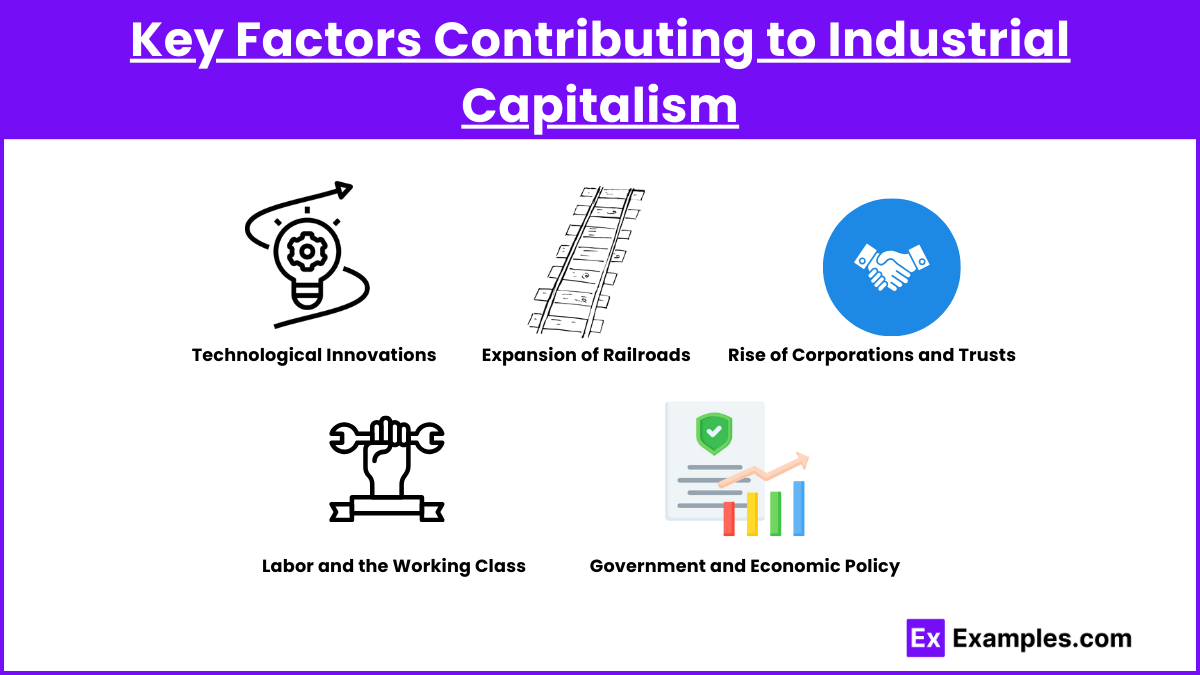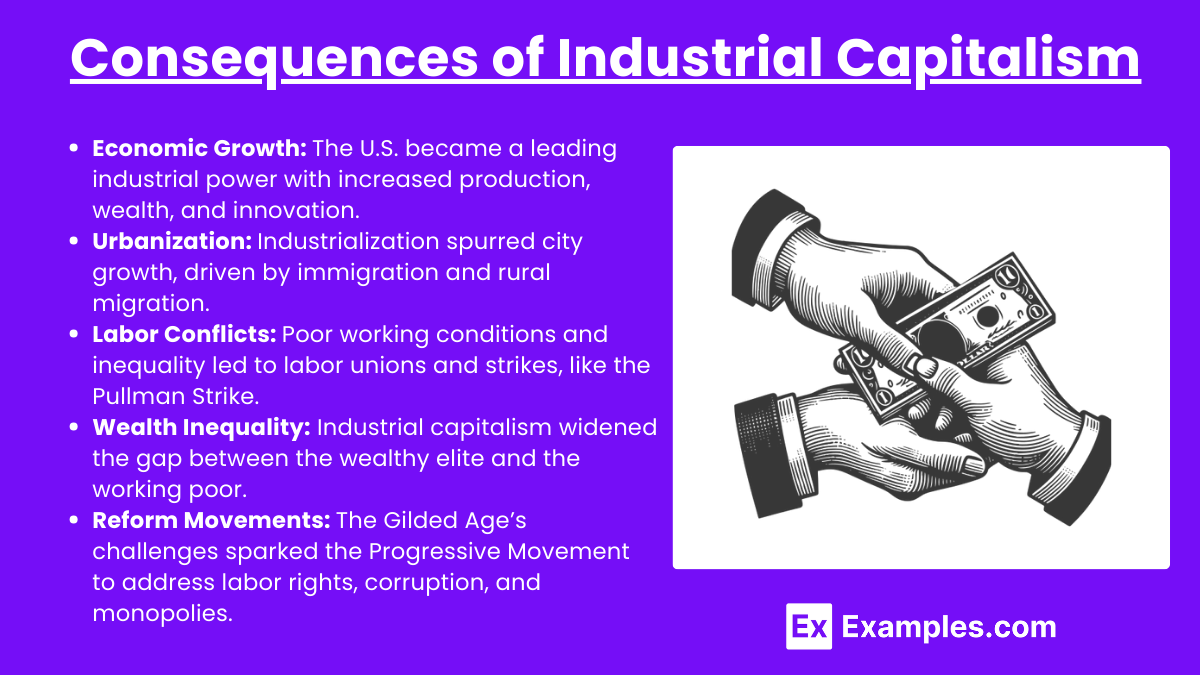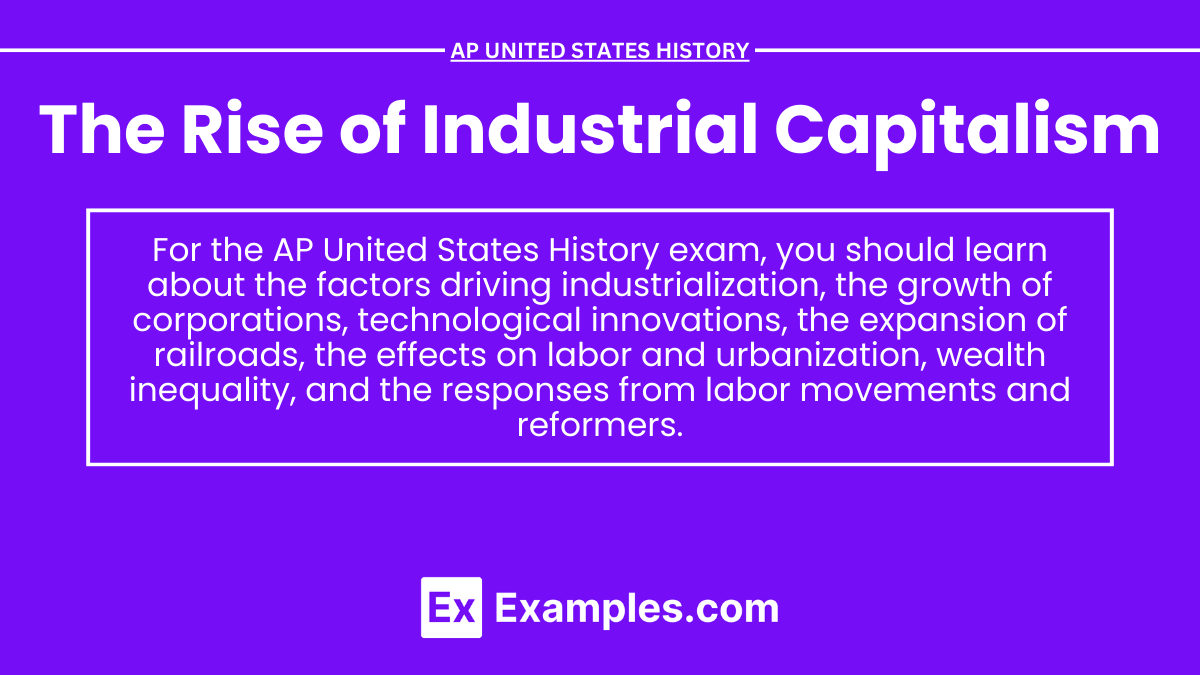In AP United States History, the Rise of Industrial Capitalism refers to the period during the late 19th century when the United States underwent rapid industrialization, leading to the growth of large corporations, technological innovation, and significant economic expansion. This era, often called the Gilded Age, saw the emergence of powerful industrialists, widespread urbanization, and the development of a national economy. However, it also brought about challenges such as labor unrest, wealth inequality, and the rise of monopolies, prompting calls for economic and social reform.
Free AP United States History Practice Test
Learning Objectives
The learning objectives for the topic "The Rise of Industrial Capitalism" will include the ability to analyze the factors that contributed to rapid industrialization, such as technological innovations, the expansion of railroads, and the rise of corporations. You will be expected to evaluate the impact of industrial capitalism on the economy, labor, and society, including the growth of urbanization and the challenges of wealth inequality. Additionally, you will be required to assess the responses to these challenges, including labor movements and government interventions.
Key Factors Contributing to Industrial Capitalism

Technological Innovations:
The late 19th century saw significant technological advancements, including the development of the telegraph, telephone, and electric power. These innovations increased efficiency and communication, enabling businesses to expand and manage operations across vast distances.
Expansion of Railroads:
Railroads were central to the rise of industrial capitalism, facilitating the movement of goods, raw materials, and people across the country. The completion of the Transcontinental Railroad in 1869 connected the eastern and western United States, opening new markets and resources.
Rise of Corporations and Trusts:
Large corporations and business trusts emerged, often dominating entire industries. Industrialists like John D. Rockefeller in oil, Andrew Carnegie in steel, and J.P. Morgan in banking amassed great wealth and power, leading to the formation of monopolies and oligopolies.
Labor and the Working Class:
Industrial capitalism transformed the American workforce, as millions of immigrants and rural Americans flocked to cities for factory jobs. Working conditions were often harsh, with long hours, low wages, and dangerous environments, leading to the rise of labor unions and strikes.
Government and Economic Policy:
The federal government adopted a laissez-faire approach, allowing businesses to operate with minimal regulation. This lack of oversight contributed to the growth of monopolies and the concentration of wealth, but also led to social tensions and calls for reform.
Consequences of Industrial Capitalism

Economic Growth: The U.S. became the world’s leading industrial power, with significant increases in production, wealth, and innovation.
Urbanization: Rapid industrialization led to the growth of cities, with populations swelling due to immigration and rural migration.
Labor Conflicts: Harsh working conditions and economic disparities led to the rise of labor unions and frequent strikes, such as the Pullman Strike of 1894.
Wealth Inequality: Industrial capitalism created a stark divide between the wealthy elite and the working poor, fueling social tensions.
Reform Movements: The economic and social challenges of the Gilded Age spurred the Progressive Movement, which sought to address issues like labor rights, corruption, and monopolies.
Examples
John D. Rockefeller and Standard Oil: Rockefeller’s Standard Oil Company dominated the oil industry, using practices like horizontal integration to create a near-monopoly.
Andrew Carnegie and U.S. Steel: Carnegie’s steel empire utilized vertical integration to control every aspect of production, from raw materials to distribution.
The Transcontinental Railroad: Completed in 1869, it revolutionized transportation and commerce, linking the country from coast to coast.
The Homestead Strike (1892): A major labor conflict at Carnegie Steel that highlighted the tensions between labor and capital during the Gilded Age.
Sherman Antitrust Act (1890): The first federal legislation aimed at curbing monopolies, though initially weakly enforced.
MCQs
Which innovation was most crucial in connecting markets and fostering the growth of industrial capitalism in the late 19th century?
A) The steam engine
B) The assembly line
C) The railroad
D) The cotton gin
Answer: C) The railroad
Explanation: Railroads played a central role in the growth of industrial capitalism by connecting distant markets, facilitating the transport of goods, and supporting the expansion of industries.
What was the primary goal of the Sherman Antitrust Act of 1890?
A) To promote unionization
B) To break up monopolies
C) To regulate banking practices
D) To increase tariffs on imports
Answer: B) To break up monopolies
Explanation: The Sherman Antitrust Act aimed to prevent the formation of monopolies and trusts that restricted competition, though it was initially weakly enforced.
Which labor conflict highlighted the tensions between labor and capital during the Gilded Age?
A) The Boston Tea Party
B) The Haymarket Riot
C) The Homestead Strike
D) The Whiskey Rebellion
Answer: C) The Homestead Strike
Explanation: The Homestead Strike of 1892 was a major labor conflict at Carnegie Steel, reflecting the broader struggles between labor and capital during the rise of industrial capitalism.


